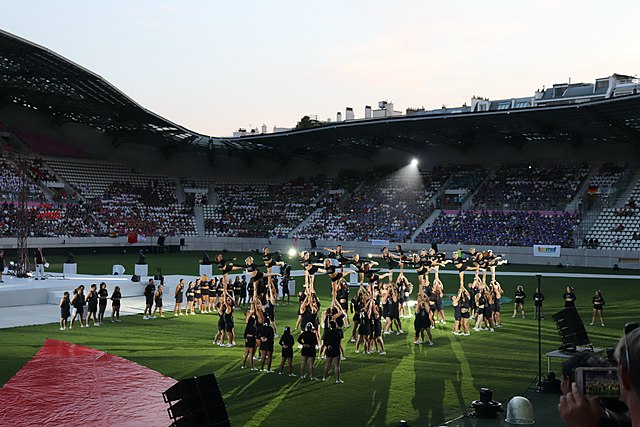Winter Guard : Sport of The Arts
Courtesy of Wikimedia Commons Submission
Winter guard is a competitive, performance-based activity that incorporates choreographed staging, dance, and the ability to spin equipment such as flags, prop rifles and sabres. Winter guard is unlike Color guard, which typically performs at half-time during football games. Winter guard performances and contests are held indoors, usually in a gymnasium or an indoor arena.
Like any other sport, Winter guard starts their season off with tryouts. Tryouts are a three day event occurring from 3:30 to 5:00 pm in the band hall. During tryouts, students are introduced to the winter guard coach and other guard members. During the first two days of tryouts, students are taught the routine they will perform on the 3rd and last day of tryouts. Sadie Novak, Sophomore, had mixed feelings when she was auditioning for Color guard.
“I first auditioned for Color Guard my freshman year. I was really nervous because I didn’t really know anything. When clinic week started, I felt better because they taught me everything like the routine and how to spin a flag. I was in a dance company in middle school so when the final audition came, I wasn’t as nervous,” say Novak.
The main difference between Color guard and Winter guard is the competitions. During Color guard season, students perform alongside the band during halftime at football games. Whenever marching bands compete, Color guard attends and creates visual performance with flags and rifles. During the Winter guard season, the team prepares for indoor competitions in recorded music. Natalie Castro, Senior, prefers Winter guard for the dance aspect, but feels like Color guard would be a good place to start.
“It is good to start in Color guard if you want to do Winter guard because you start off with the basic spinning movements and dance steps. Winter guard does go a bit faster. For me, I enjoy Winter guard more than Color guard because I feel like there are more dance aspects to it compared to Color guard where we are marching alongside the band,” says Castro.
Winter guard practices are split up into two days a week for the JV and Varsity team. Monday and Wednesday practices are for the Varsity team and Tuesday and Thursday practices are for the JV team. During practice, guard members are encouraged to dance barefoot because of the type of floor pads that are used during competitions. Erin Cole, Junior feels that the amount of practice is enough for competition.
“Our first competition is around February so it is coming up very fast, so we do have about a month to prepare a 5 minute show, but I do think Ms. York does as a fantastic job with teaching choreography and having time management skills during practice,” says Cole.
Joining Winter guard, students don’t have to have previous experience dancing to join the guard team. Guard members incorporate many different styles of dance into their shows. The most common styles of dance used are modern, contemporary, lyrical, jazz, and ballet. The different styles of dances are chosen depending on the different types of music chosen and the themes of the shows. Megan York, Winter Guard instructor gets inspiration for her choreography by the things around her.
“I feel like I’m inspired by a multitude of events, everything from performances that I see on TV, to artist and pop culture. My students also inspire me a lot, seeing them come alive with the many different styles of movements and I still practice dance myself so I try to incorporate my own dance skill into the routine.
The three types of different equipment used in Winter guard are Flags, Rifles, and Sabers. When new students join winter guard for the first time, they primarily start off with flags and move up to rifles and sabers as their skill in maneuvering the equipment progresses. While winter guard flags come in many different sizes and shapes, a standard size is a six-foot metal with a 36 inch tall by 54 inches wide silk. Sabres and Rifles have been visually designed to look similar to the original. However, they do not cause harm or danger. Most of the equipment weighs between 2 and 5 pounds.

- Grade 12 with 4 years of experience.
Hi! My name is Valeria Ramirez and I'm the Publishing Editor for Newspaper. I was motivated to join to strengthen...

